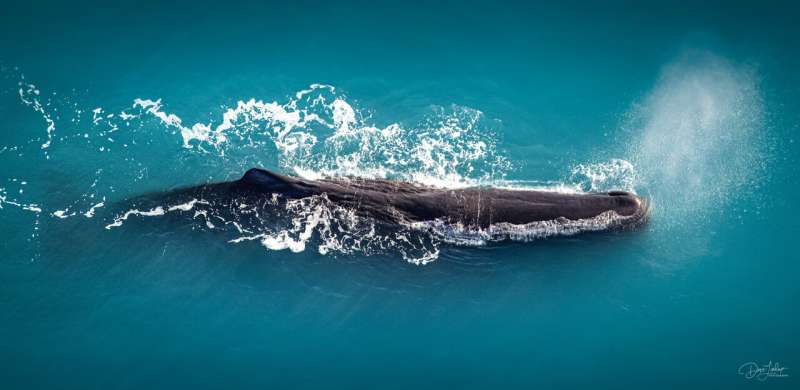Sperm whale. Credit: DBL Wildlife
New research sheds light on how climate change will affect the distribution of large whales in New Zealand’s waters.
An international collaborative study between Massey University, the University of Zurich, Canterbury University and Flinders University used a complex modeling approach to project the regional shift of blue and sperm whales by the year 2100, under different climate change scenarios.
The study, published in the international journal Ecological indicators, shows a southerly shift of suitable habitat for both species, increasing in size as the ocean warms. The most severe climate change scenario tested generated a 61 percent loss and a 42 percent decrease in the currently suitable habitat for sperm whales and blue whales, mainly in New Zealand’s northern waters.
Research leader Dr. Katharina Peters of the University of Canterbury says that “Regardless of which of the climate change scenarios will be a reality, even the best-case scenario points to remarkable changes in the distribution of suitable habitat for sperm and blue whales in New Zealand.”
Island nations such as New Zealand are extremely vulnerable to the impacts of climate change on marine ecosystems due to their strong connection to the ocean. Sperm whales in New Zealand, for example, are critical to the tourism industry and local economy.
Blue whale. Credit: DBL Wildlife
Study co-author Professor Karen Stockin, who leads the Cetacean Ecology Research Group at Massey University, says “the whale watching industry off the coast of Kaikoura is at potential risk due to fewer and less reliable sperm whale sightings off that coastline in Such changes in the distribution of sperm whales would have socio-economic consequences because of the direct and indirect reliance of the local economy on whale watching activities.”
Large whales, such as sperm whales and blue whales, are important ecosystem engineers. This means they perform a variety of tasks, such as facilitating the transfer of nutrients from deep water to the surface and across latitudes via migration from feeding to calving areas. Their predicted future shift south, driven by climate change, will affect ecosystem functioning and potentially destabilize ecological processes in the northern part of New Zealand.
The major regional changes of whales predicted by complex modelling. Credit: Katharina Peters
While this study highlights the negative effects of climate change on blue whales and sperm whales, it also highlights habitats that could be suitable for both South Island and offshore islands species in the future.
Senior author Dr. Frédérik Saltré, co-leader of the Global Ecology Lab at Flinders University, says that “such areas have the potential to serve as climate refuges for both species. Knowing these areas early on can help protect them better in the future.” future, especially when considering the placement of marine protected areas and oil and gas exploration legislation.”
Whale beaches in New Zealand ‘linked to ocean warming’
Katharina J. Peters et al, On the rise: Climate change in New Zealand will cause sperm whales and blue whales to seek higher latitudes, Ecological indicators (2022). DOI: 10.1016/j.ecolind.2022.109235
Quote: Climate change predicts southern shift of large whale species in New Zealand (2022, Aug 8), retrieved Aug 8, 2022 from https://phys.org/news/2022-08-climate-southerly-shift-great-whale.html
This document is copyrighted. Other than fair dealing for personal study or research, nothing may be reproduced without written permission. The content is provided for informational purposes only.

